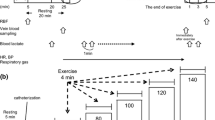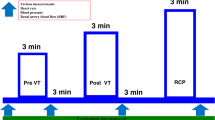Abstract
Background
Acute exercise reduces renal blood flow (RBF). However, the effect of exercise intensity on RBF in patients with chronic kidney disease (CKD) stage 2 is not known. We investigated the association between RBF and exercise intensity in patients with CKD stage 2 using pulsed Doppler ultrasonography.
Methods
Eight men with CKD stage 2 (cystatin C-based estimate of glomerular filtration rate: 60–89 ml/min/1.73 m2) participated in this study. Using a bicycle ergometer, participants undertook a maximal graded exercise test (MGET) (experiment 1) and a multi-stage exercise test (experiment 2) to determine their lactate threshold (LT). Participants undertook a multi-stage exercise test for 4-min each. Workloads of 60%, 80%, 100%, 120%, and 140% of LT were used in experiment 3. RBF was measured by pulsed Doppler ultrasonography at rest, immediately after exercise, and 1 h after exercise in experiment 1, and at rest and immediately after each exercise bout in experiment 3.
Results
Renal blood flow after the MGET was 52% lower than at rest, and did not recover as well as after the exercise test. Cross-sectional area (CSA) was significantly lower after graded exercise. RBF tended to be lower at 100% of LT and was significantly lower at 120% of LT. CSA was significantly lower at 100% of LT.
Conclusions
Renal blood flow does not change during exercise until the LT is reached. These findings may assist in making appropriate exercise recommendations to patients with CKD stage 2.



Similar content being viewed by others
References
Imai E, Horio M, Iseki K, Yamagata K, Watanabe T, Hara S, Ura N, Kiyohara Y, Hirakata H, Moriyama T, Ando Y, Nitta K, Inaguma D, Narita I, Iso H, Wakai K, Yasuda Y, Tsukamoto Y, Ito S, Makino H, Hishida A, Matsuo S. Prevalence of chronic kidney disease (CKD) in the Japanese general population predicted by the MDRD equation modified by a Japanese coefficient. Clin Exp Nephrol. 2007;11:156–163.
Japanese Society of Nephrology. Evidence-based clinical practice guideline for CKD 2013. Clin Exp Nephrol. 2014;18:346–423.
Foley RN, Murray AM, Li S, Herzog CA, McBean AM, Eggers PW, Collins AJ. Chronic kidney disease and the risk for cardiovascular disease, renal replacement, and death in the United States Medicare population, 1998 to 1999. J Am Soc Nephrol. 2005;16:489–95.
Michishita R, Matsuda T, Kawakami S, Kiyonaga A, Tanaka H, Morito N, Higaki Y. The association between unhealthy lifestyle behaviors and the prevalence of chronic kidney disease (CKD) in middle-aged and older men. J Epidemiol. 2016;26:378–85.
Beddhu S, Baird BC, Zitterkoph J, Neilson J, Greene T. Physical activity and mortality in chronic kidney disease (NHANES III). Clin J Am Soc Nephrol. 2009;4:1901–6.
Inker LA, Astor BC, Fox CH, Isakova T, Lash JP, Peralta CA, Tamura MK, Feldman HI. KDOQI US commentary on the 2012 KDIGO clinical practice guideline for the evaluation and management of CKD. Am J Kidney Dis. 2014;63:713–35.
National Kidney Foundation. KDOQI clinical practice guideline for diabetes and CKD: 2012 update. Am J Kidney Dis. 2012;60:850–86.
Poortsmans JR. Exercise and renal function. Sports Med. 1984;1:125–53.
Castenfors J. Renal function during exercise. Acta Physiol Scand. 1967;70(Suppl. 293):1–44.
Castenfors J. Renal function during prolonged exercise. Ann N Y Acad Sci. 1977;301:151–9.
Grimby G. Renal clearances during prolonged supine exercise at different loads. J Appl Physiol. 1965;20:1294–8.
Suzuki M. Physical exercise and renal function. J Phys Fit Sports Med. 2015;4:17–29.
Kawakami S, Yasuno T, Matsuda T, Fujimi K, Ito A, Yoshimura S, Uehara Y, Tanaka H, Saito T, Higaki Y. Association between exercise intensity and renal blood flow evaluated using ultrasound echo. Clin Exp Nephrol. 2018. https://doi.org/10.1007/s10157-018-1559-1 (Epub ahead of print).
Johansen KL. Exercise and chronic kidney disease current recommendations. Sport Med. 2005;35:485–99.
Kirkman D, Edwards DG, Lennon-Edwards S. Exercise as an adjunct therapy in chronic kidney disease. Renal Nutr Forum. 2014;33:1–8.
Johansen KL, Painter P. Exercise in individuals with CKD. Am J Kidney Dis. 2012;59:126–34.
Momen A, Leuenberger UA, Ray CA, Cha S, Handly B, Sinoway LI. Renal vascular responses to static handgrip: role of muscle mechanoreflex. Am J Physiol Heart Circ Physiol. 2003;285:H1247–53.
Momen A, Bower D, Leuenberger UA, Boehmer J, Lerner S, Alfrey EJ, Handly B, Sinoway LI. Renal vascular response to static handgrip exercise: sympathetic vs. autoregulatory control. Am J Physiol Heart Circ Physiol. 2005;289:H1770–6.
Endo MY, Suzuki R, Nagahata N, Hayashi N, Miura A, Koga S, Fukuba Y. Differential arterial blood flow response of splanchnic and renal organs during low-intensity cycling exercise in women. Am J Physiol Heart Circ Physiol. 2008;294:H2322–6.
Lesley AS, Josef C, Christopher HS, Harold IF, Marc F, John K, Jerome R, Frederick VL, Robert DB, Yaping Z, Tom G, Andrew SL. Estimating GFR using serum cystatin C alone and in combination with serum creatinine: a pooled analysis of 3418 individuals with CKD. Am J Kidney Dis. 2008;51(3):395–406.
Horio M, Imai E, Yasuda Y, Matsuo S, et al. GFR estimation using standardized serum cystatin C in Japan. Am J Kidney Dis. 2013;61(2):197–203.
Matsuo S, Imai E, Horio M, Yasuda Y, Tomita K, Nitta K, Yamagata K, Tomino Y, Yokoyama H, Hishida A, et al. Revised equations for estimated GFR from serum creatinine in Japan. Am J Kidney Dis. 2009;53(6):982–92.
Suzuki M. Exercise and renal function. Adv Ex Sports Physiol. 1996;2:45–56.
Ueda J, Nakanishi H, Miyazaki M. Effects of glucagon on the renal hemodynamics of dogs. Jpn Circ J. 1977;41:991–6.
Monika JB, et al. Specificity and sensitivity of commercially available assays for glucagon and oxyntomodulin measurement in humans. Eur J Endocrinol. 2014;170:529–38.
Brenner BM, Garcia DL, Anderson S. Glomeruli and blood pressure. Less of one, more the other? Am J Hypertens. 1988;1:335–47.
Anderson S, Meyer TW, Rennke HG, Brenner BM. Control of glomerular hypertension limits glomerular injury in rats with reduced renal mass. J Clin Invest. 1985;76:612–9.
Tanaka H, Shindo M, Gutkowska J, Kinoshita A, Urata H, Ikeda M, Arakawa K. Effect of acute exercise on plasma immunoreactive—Atrial natriuretic factor. Life Sci. 1986;39:1685–93.
Sanders LR. Exercise-induced acute renal failure associated with ibuprofen, hydrochlorothiazide, and triamterene. J Am Soc Nephrol. 1995;5:2020–3.
Acknowledgements
We acknowledge the contribution of the staff at Fukuoka University, who helped with the recruitment of participants and data analyses in our study. We are grateful to the participants in this study. This work was supported by JSPS KAKENHI (15H03082) to Y.H., and Fukuoka University Institute for Physical Activity, Fukuoka, Japan.
Author information
Authors and Affiliations
Corresponding author
Ethics declarations
Conflict of interest
The authors declare that no conflict of interest exists.
Ethical approval
All procedures carried out in studies involving human participants were in accordance with the ethical standards of the institutional and/or national research committee at which the studies were conducted (Ethics Committee of Fukuoka University approval number 16-4-01) and with the 1964 Helsinki declaration and its later amendments or comparable ethical standards.
Informed consent
Informed consent was obtained from all participants included in the present study.
Additional information
Publisher’s Note
Springer Nature remains neutral with regard to jurisdictional claims in published maps and institutional affiliations.
About this article
Cite this article
Kotoku, K., Yasuno, T., Kawakami, S. et al. Effect of exercise intensity on renal blood flow in patients with chronic kidney disease stage 2. Clin Exp Nephrol 23, 621–628 (2019). https://doi.org/10.1007/s10157-018-01685-3
Received:
Accepted:
Published:
Issue Date:
DOI: https://doi.org/10.1007/s10157-018-01685-3




